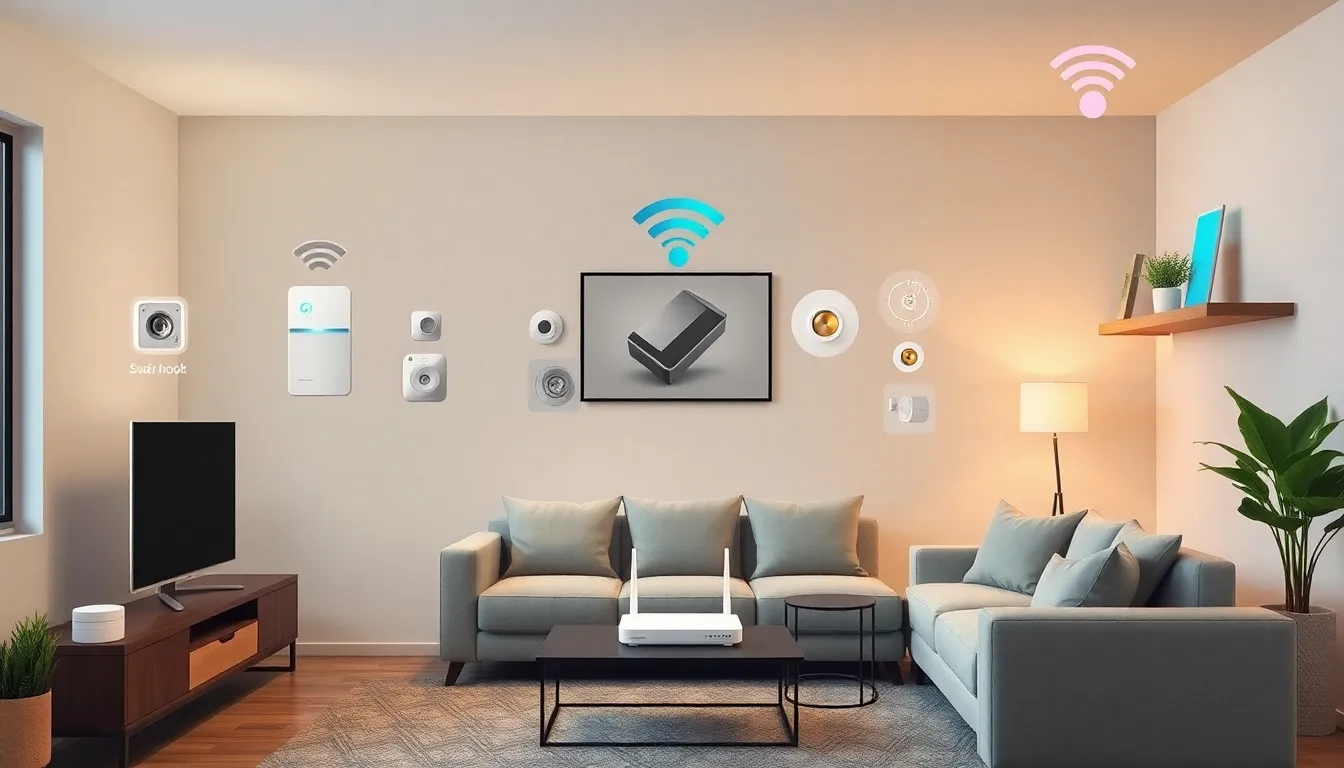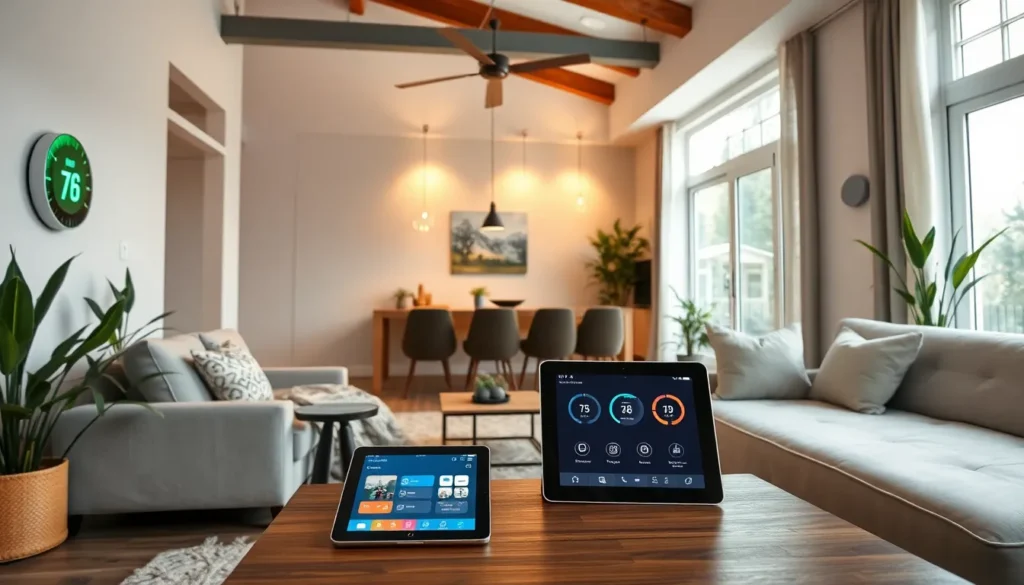Imagine walking into your home and having it greet you like an old friend. Lights flicker on, the thermostat adjusts to your perfect temperature, and your favorite playlist starts playing. Home automation networking makes this dream a reality, transforming ordinary houses into smart havens.
Overview of Home Automation Networking
Home automation networking forms the backbone of modern smart homes. This network enables various devices and systems to communicate, ensuring seamless integration for enhanced functionality. Different technologies, including Wi-Fi, Zigbee, Z-Wave, and Bluetooth, support this communication among devices.
Devices such as smart thermostats, lights, and speakers connect to the network, allowing users to control them remotely. These connections provide opportunities for automation sequences, like those that trigger lights to turn on when someone enters a room.
Homeowners often use mobile apps or voice commands to interact with devices, simplifying management. Consider the advantage of monitoring energy consumption through smart plugs and thermostats, leading to increased efficiency. Data from connected devices helps residents optimize usage, reduce costs, and enhance comfort.
Security cameras and smart locks integrate into the network, increasing peace of mind. Users can receive alerts on their smartphones and monitor their homes in real time. Remote access ensures homeowners can secure their properties from anywhere, addressing potential concerns.
Customization plays a critical role in home automation networking. Users create personalized settings, tailoring experiences to their preferences. Home automation also supports schedules and routines, promoting convenience and improving daily living.
Adoption of these technologies continues to grow, leading to advancements in the overall efficiency of home systems. Industry trends show a steady increase in the market, highlighting the shift toward smart living environments. The combination of connectivity and automation significantly enhances the dynamics of modern households.
Key Components of Home Automation Networks

Home automation networks rely on essential hardware and software components to function effectively. Understanding these components ensures optimal performance and user satisfaction.
Hardware Requirements
Devices form the backbone of home automation networks. Smart hubs connect various devices, coordinating communication. Sensors, including motion detectors and temperature sensors, provide valuable data to enhance automation. Smart lights offer flexible control over ambiance and energy efficiency. Security cameras and smart locks add layers of protection. Wi-Fi routers maintain consistent connectivity among devices. In many cases, mesh networks extend coverage throughout the home. Power supplies ensure uninterrupted operation, keeping devices functional at all times.
Software Requirements
Software plays a crucial role in managing home automation systems. Mobile applications provide user-friendly interfaces for controlling devices remotely. Cloud services enable data storage, facilitating access and updates. Integration platforms allow multiple brands and devices to communicate seamlessly. Operating systems designed for smart home devices enhance compatibility. Voice assistants streamline user experience through convenient verbal commands. Automation protocols like Zigbee and Z-Wave facilitate communication between different brands, optimizing interactions. Regular software updates ensure security and improve functionality over time.
Types of Home Automation Networking
Home automation networking primarily consists of wired and wireless systems. These types define how devices within a smart home connect and communicate.
Wired Networks
Wired networks provide stable connections through physical cables. Ethernet cables are commonly used to connect devices like smart hubs and security cameras directly to the network. Reliability becomes a major benefit as wired connections often suffer less interference. Installation efficiency plays a crucial role, necessitating careful planning to accommodate cable placements. A setup with wired networks supports higher speeds and better security against unauthorized access, making it ideal for users who prioritize performance.
Wireless Networks
Wireless networks leverage radio waves for device communication without physical cables. Technologies like Wi-Fi, Zigbee, and Z-Wave each serve unique purposes in smart home setups. Flexibility becomes a significant advantage since homeowners can position devices anywhere within range without worrying about cabling. Wireless networks also simplify the addition of new devices as they expand, fostering easier upgrades. Security protocols like encryption enhance safety, protecting data transmitted over the air. The user-friendly nature of wireless networking encourages homeowners to explore diverse automation opportunities in their living spaces.
Benefits of Home Automation Networking
Home automation networking offers numerous advantages for modern households. Increased convenience ranks among the most significant benefits, allowing devices to connect seamlessly. Homeowners control lighting, temperature, and security with intuitive mobile apps or voice commands.
Energy efficiency plays a crucial role in the overall appeal. Smart devices monitor energy consumption in real-time, helping users identify areas for savings. Studies show that automated systems can reduce energy costs by up to 30%.
Enhanced security features contribute extensively to peace of mind. Integrated cameras and smart locks alert users to potential threats instantly. Monitoring capabilities provide real-time access to the home environment from anywhere, keeping families safe.
Personalization brings another layer of advantage. Users create tailored settings and routines that adapt to their lifestyles. Customizing schedules for heaters, lights, and music enhances comfort, matching preferences throughout the day.
Accessibility remains vital for households with varying needs. Voice-activated systems empower users with mobility challenges, enabling them to manage home functions independently. Moreover, the integration of smart technologies supports inclusive living and enhances quality of life.
Scalability provides homeowners with flexibility. Users can start with a few devices and expand their systems as needed. Upgrading components is straightforward, especially when following industry-standard protocols like Zigbee or Z-Wave.
Cost savings from automating daily tasks also appeal to many. Automation reduces the need for manual intervention, cutting down on wear and tear on appliances. Overall satisfaction and comfort improve, promoting a higher quality of living.
Challenges and Considerations
Security remains a primary concern for users implementing home automation networking. Devices often connect to the internet, which increases vulnerability to cyberattacks such as hacking or data breaches. Properly configuring security settings and updating passwords strengthens defense against these risks.
Compatibility among various devices presents another challenge. Not all smart devices use the same protocols, potentially limiting integration. Homeowners should research compatibility before purchasing new devices to ensure seamless functionality within their existing networks.
Network reliability also requires attention. A weak Wi-Fi signal can disrupt communication between devices, leading to frustration during use. Investing in a robust router or a range extender enhances coverage and improves overall performance.
Cost considerations factor into the decision-making process. Initial investments can add up, especially as homeowners expand their systems with multiple devices. Budget-conscious users may choose to start small and gradually scale their networks to manage expenses effectively.
Technical knowledge significantly influences user experience. Individuals unfamiliar with technology might struggle with installation and troubleshooting. Supported documentation, tutorials, and professional installation services simplify the onboarding process for less tech-savvy users.
Privacy issues present yet another layer of complexity. Many devices collect data to enhance functionality, raising concerns about personal information security. Users must stay informed about their devices’ data-handling practices and choose options that prioritize user privacy and control.
Energy consumption is critical as well. While automation can enhance efficiency, improper configuration may negate these savings. Homeowners are encouraged to periodically review their systems and settings to ensure they operate at optimal levels.
Sustainability plays a role in future considerations. As the demand for energy-efficient devices rises, manufacturers increasingly focus on eco-friendly solutions. Choosing products with environmentally responsible design aligns home automation ventures with sustainable living goals.
Home automation networking is revolutionizing the way people interact with their living spaces. By integrating smart devices and systems, homeowners can create a tailored environment that enhances comfort and efficiency. The ability to control various aspects of the home through mobile apps or voice commands not only simplifies daily routines but also contributes to significant energy savings.
As technology continues to evolve, the potential for home automation will only grow. With a focus on security, compatibility, and user accessibility, homeowners can confidently embrace these innovations. The shift toward smarter living environments reflects a commitment to enhancing quality of life, making home automation an essential consideration for modern households.













